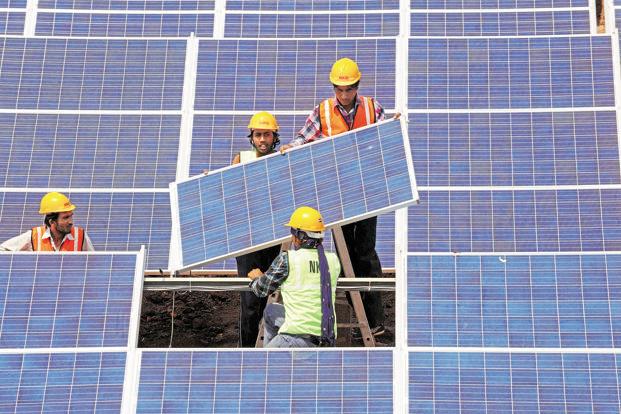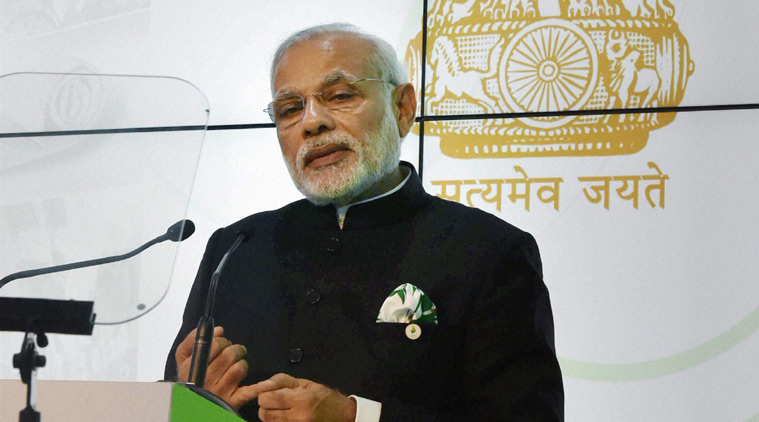Renewable energy firms have been quoting record low tariffs in government auctions to win solar projects in India.
Such tariffs could prove to be unviable—disappointing investors looking for steady returns, say experts.
Firms such as SunEdison Inc. and SB Energy Corp., a joint venture between SoftBank Group Corp., Bharti Enterprises Ltd and Foxconn Technology Co. Ltd, have been bidding aggressively in auctions after India raised its solar power capacity target five-fold to 100 gigawatts by 2022. Bidding in two separate reverse e-auctions under the Jawaharlal Nehru National Solar Mission saw US’s SunEdison, SB Energy and local firms like Yarrow Infrastructure Ltd, Reliance CleanGen Ltd and Azure Power India Pvt. Ltd bid lower than Rs.5 per kilowatt-hour (kWh),raising concerns about the long-term viability of these projects.
In a reverse auction, the role of buyer and seller is reversed and a business bid is won by quoting prices downwards.
SunEdison quoted Rs.4.63 per unit to win the 500 megawatt (MW) project in Andhra Pradesh in November, beating 27 other bidders, of which at least nine had offered tariffs below Rs.5.
Bidders included SB Energy, which went on to win the second auction—a 350MW project in Andhra Pradesh—last week by quoting Rs.4.63 per unit. State-run NTPC Ltd, India’s biggest power producer, will buy power from both the projects that will be located within the government- developed solar parks.
“I think the current bids are far too aggressive and competitive bidding route, while reducing tariffs in the short term, is quickly leading to consternation that India despite, higher volume, is becoming an unattractive market from a returns point of view,” said Sumant Sinha, founder and chief executive at renewable energy firm ReNew Power Ventures Pvt. Ltd.
ReNew Power, backed by Goldman Sachs SA and the Asian Development Bank, was also a bidder in both the auctions. In the first one, it bid at Rs.4.85 per unit but went with a higher bid of Rs.5.17 in the second auction.
Low tariffs will result in bidders, or their vendors, either taking inordinate risks or cutting corners to squeeze out some returns, Sinha said.
The main reason for aggressive bidding in both the auctions was because these were the first two projects to be bid under the government-provided solar parks, which means the developers get ready-to-use infrastructure, such as land and transmission facilities, leading to low project risk and lower costs.
Foreign firms, looking to make big bang announcements in India, see this as an attractive bet compared to state-level auctions, which would require them to acquire land and build infrastructure support.
“The international developers are very concerned about the offtake risk, and NTPC offers a much better offtake risk profile in comparison to the state distribution companies,” said Vinay Rustagi, managing director at the Delhi-based consulting firm Bridge To India Pvt. Ltd.
But there is still no walking away from the fact that these tariffs are very aggressive, taking into account a whole host of operating and policy risks in India, Rustagi said. “There is a fear that some of the developers looking at investing in India may be put off by the Indian market due to the unviable tariffs and returns.”
Even as these solar tariffs are close to achieving grid parity or becoming affordable, questions are being raised about the sustainability of such low rates— whether the firms would compromise on quality or returns, or flip the assets to another buyer in future. India is one of the few markets globally to go with a reverse auction-derived price.
Some of the foreign firms may also come in with cheaper borrowings in dollars or Japanese yen and have an edge over their Indian counterparts, whose cost of borrowing may be higher by 4%-7%.
According to Bridge to India, the competition is likely to ease once some of the aggressive and successful developers reach their investment appetite limit.
But that will depend on how fast the government comes out with all the planned allocations.
“Solar park and NTPC are a brilliant move by the government which pushes the risk in the project way lower and thus the bids are at lower tariff than some of the state bids,” said Pashupathy Gopalan, president (Asia Pacific) at SunEdison. The current tariff levels are “competitively discovered” prices,he said.
ReNew’s Sinha said the current low tariffs do not augur well for the government’s target of achieving 100 GW in next seven years. “As we need many more players and many more investors to be entering the sector rather than shying away from it on account of low returns,” he said.
SB Energy’s chief executive Raman Nanda declined to comment.
India has seen a flurry of multi-billion-dollar investment commitments in recent months from global firms such as Italy’s Enel Green Power SpA, private equity (PE) investor The Abraaj Group, China’s Trina Solar, US-based First Solar Inc. and Russia’s OAO Rosneft. SoftBank itself plans to invest $20 billion in Indian solar sector and set up 20 GW capacity over time.
From 10MW in March 2010, solar power capacity in India rose to more than 3,000 MW in December 2014, according to Crisil Ratings. Still, solar power consumption, at present, is about 1% of the overall energy consumption. The share is likely to increase to about by 2030, though coal will continue to be India’s main source of power, Mint reported in November.
This year, auctions under the Jawaharlal Nehru National Solar Mission are likely to come up in several states including Rajasthan, Uttar Pradesh, Karnataka, Telangana,Maharashtra and Gujarat. In addition to these, Jharkhand, Karnataka and Haryana are planning to host separate auctions in the coming months.
Developers need to be wary of the risks they are undertaking while bidding for solar projects, given the sector is not mature enough to learn from risks of past projects, said Ashish Agarwal, director (infrastructure) at Equirus Capital Pvt. Ltd, an investment bank.
India launched National Solar Mission in 2010 to add 20GW of grid-connected solar power to India’s energy mix by 2022 in three phases. Of the total current target of 100GW by 2022, 20GW will come from solar parks and 40GW each from roof-top and distributed generation projects. The government plans to set up 25 solar power parks.
In the last financial year, the average rate of electricity sold by NTPC’s coal-fuelled projects was Rs.3.25 per unit, while the tariff of power from its other projects ranged between Rs.2 and Rs.4.50 a unit.




